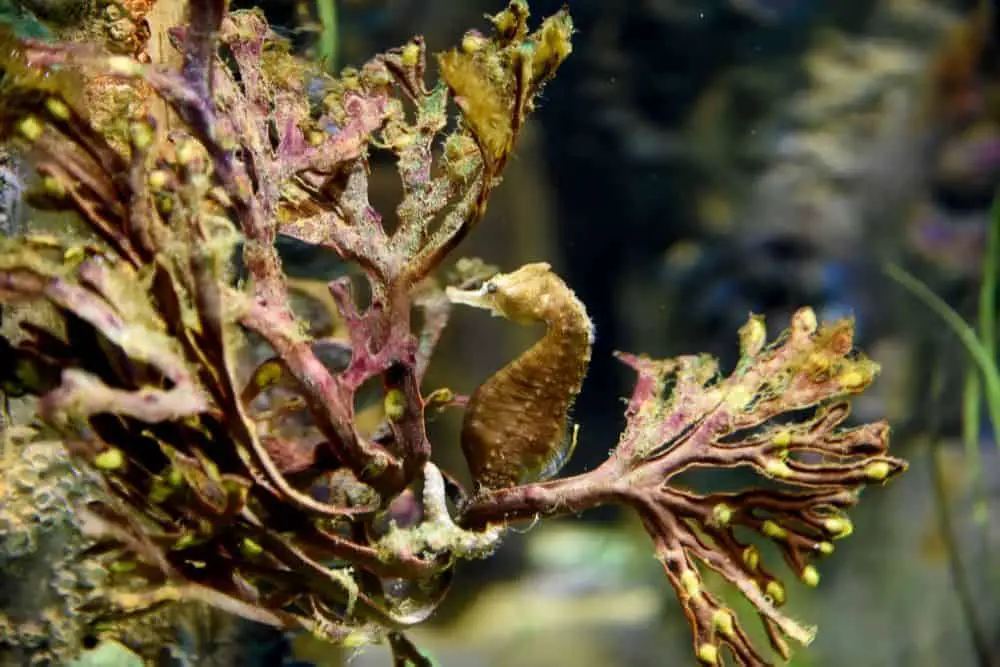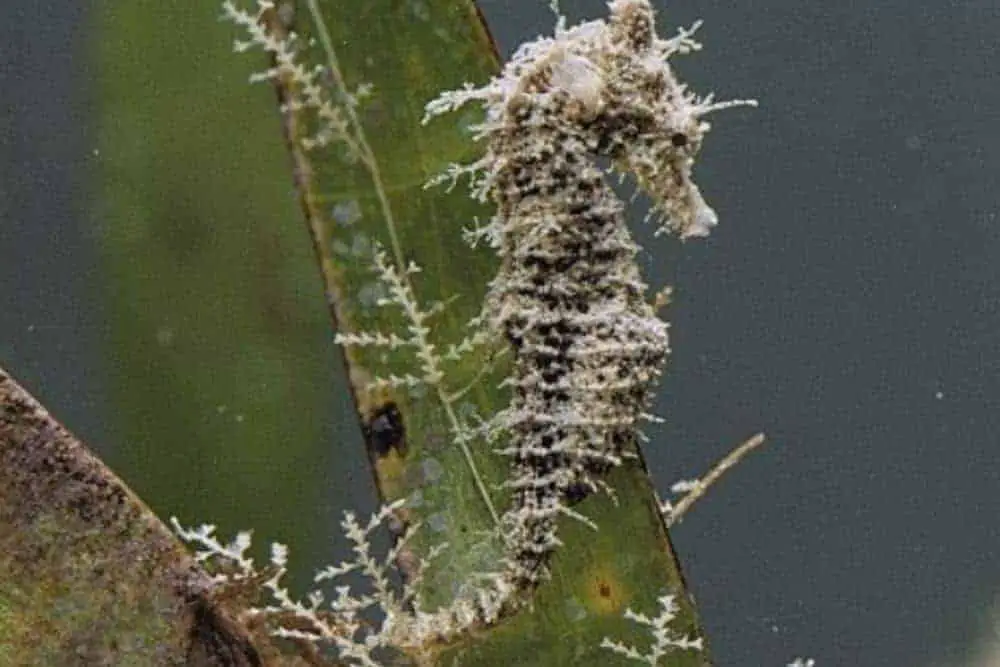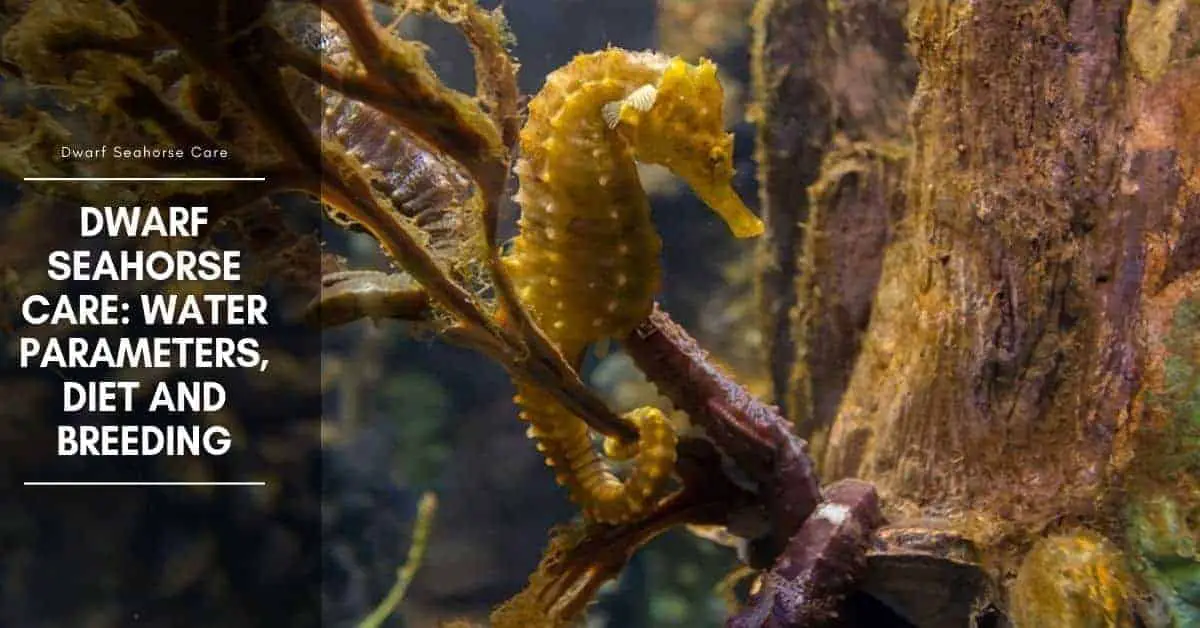Over more recent years there have been many scientific studies carried out and new species are still being discovered, enhancing our understanding of seahorses. The scientific name for dwarf seahorses is, Hippocampus zosterae. In the wild, dwarf seahorse found in the shallows amongst the Zostera seagrass beds, (after which they are named) throughout the Gulf of Mexico, Florida, and Cuba.
Living in the shallow, inshore waters subjects them to widely variable conditions, giving some indication of how tough these tiny creatures really are, contrary to popular belief! In any one day they could be in crystal clear water amongst the seagrass and the next moment a tidal surge could send them so far inshore that they are in foul-smelling, muddy water, barely a few centimeters (inches) deep with the temperature soaring! This means over a period of just a few hours both the salinity of the water and the temperature will have fluctuated widely.
As fish go they just do not come any tougher! This must bring into question the popular belief that dwarf seahorses need special care and daily water changes? We will be looking at their needs in detail later in this article.

Dwarf Seahorse Description
Coloration
Dwarf seahorse coloration can vary and, as with all seahorses, they can change color to reflect their mood. Their resting, base color is usually brown or by contrast – white. However, they can change at a moment’s notice ranging from white to cream to yellow and orange – I have even seen red and even more unusual, green.
These color changes are often brought about by their need to blend in with their environment for surviving in the wild. They can change rapidly and through a wide range of colors during their ritual courtship dancing, indicating their willingness to mate. You can actually take advantage of this ability to change color by using plants of different colors in the aquarium, yellow plants will encourage a natural yellow color in your dwarf seahorses.
Size
Dwarf seahorses typically measure between 2.5cm – 3.8cm (1in – 1.5in) from snout to tip of the tail. They are not the smallest seahorses in the Ocean, that title goes to the Hippocampus bargibanti or Pigmy Seahorse, measuring just 1.5cm (0.6 in).
Lifespan
In the wild, life expectancy is only about one year, but given the proper care in a home aquarium, we can extend this to an average of 2 years. This short life cycle means they reproduce frequently and readily.
Breeding
Fortunately, they will breed easily in the aquarium from about 3 months old, rapidly increasing your herd! I am sure you will be aware that it is the male that gets pregnant and gives birth to live free-swimming fry, as with all species of seahorses. The female deposits her eggs in the male’s pouch, where he nurtures them for about 10 days before opening his pouch and ejecting the self-sufficient babies.
He can deliver any number of fry from just 2 or 3 up to about 30 plus, an average number would be about 18. Being a highly sociable creature, dwarf seahorses always fair better in large groups and this should be something to consider when making your first purchase. You are more likely to succeed in breeding them with a group of 10 than you would with only 5 – or less. They need to satisfy that herding instinct that is hardwired within them for them to settle and become interested in reproducing.
Keeping Dwarf Seahorse In The Aquarium
If you have kept standard seahorses, you are going to be surprised at how different the recommended aquarium size is and how many you can keep in it. Dwarf seahorses are very small and do not need a lot of space. The maximum size you should consider is 30 liters (10 gallons) and the minimum size should be 15L (5 gallons).
Some do keep small groups in 3 gallons, but with aquariums this size, maintaining water quality becomes more of an issue, and as with any species of seahorse, water quality is key.
Another reason for using a comparatively small aquarium is the ease of being able to maintain a good density of live food. As they only eat live food, mainly newly hatched baby brine shrimp, it must be available to them at all times. It should be in a quantity that resembles a cloud in the water, rather like a child’s snow globe. With an aquarium larger than 10 gallons maintaining that density would be very difficult.
Dwarf seahorses are very lazy, they like to hitch themselves to a suitable plant and then simply wait for their prey to swim past the end of their snout from where it is quickly snapped up. Unlike other fish and seahorses, dwarf seahorses very rarely go off actively hunting or chasing down their food. They much prefer to wait until the food comes to them.
API STRESS COAT Aquarium Water Conditioner 16-Ounce Bottle
29% OffAPI STRESS ZYME Freshwater and Saltwater Aquarium Cleaning Solution 16-Ounce Bottle
API ACCU-CLEAR Freshwater Aquarium Water Clarifier 4-Ounce Bottle
13% Off
Water Parameters
To summarise, your seahorses will need a clean tank, lots of good quality clean water of a particular salinity and biologically filtered and temperature maintained.
All seahorses live in saltwater, although the salinity may vary a little in different parts of their territory. Salinity is the amount of salt in the water and is measured by using an aquarium hydrometer or a more accurate instrument called a refractometer.
Salinity
Dwarf Seahorses need a specific gravity (SG) of between 1.022 – 1.024sg. An alternative measurement is salinity content, measured in parts per thousand (ppt), this would equate to 29 – 32 ppt. As this article is primarily designed for the beginner we will be using the specific gravity scale (SG) as it is in more common everyday use.
There are three options available to you when considering which type of saltwater you are going to use.
- Synthetic Salt Water
- Self-Mixed Water
- Natural Sea Water.
Synthetic Salt Water
Starting with the easiest option, you can simply buy your saltwater ready mixed from your local fish shop. Although it may vary a little from shop to shop, the specific gravity is usually set at around 1.022, which is fine for our seahorses. You should, however, always ask the dealer what the levels are at the time of purchase, but also get in the habit of checking the level for yourself before use. It will have been mixed by using RO filtered (Reverse Osmosis) water and a brand of marine salts. RO water is purified water which has had all impurities such as heavy metals, minerals, and chlorine, etc., removed.
Self-Mixed Water
The second method is to mix the saltwater yourself. You will need a supply of RO fresh water which you can produce yourself by using an RO filter connected to your domestic water supply, or buy it ready-made from your fish shop. Tap water is forced at high pressure through a very fine membrane that filters out the impurities, but it is a very slow process. There is also a lot of wastage involved, 60 to 70% of the water run through the filter goes to waste – not good if you are on a water meter! The wastewater can be used domestically for watering the garden or flushing toilets etc.
When you have produced a sufficient quantity of filtered water, you mix in a specific amount of marine sea salts, according to the manufacturer’s instructions.
Natural Sea Water
The third method is natural seawater, which is becoming increasingly popular amongst marine aquarists. Obviously, it depends on where you live and the economics of traveling and the convenience of collecting from the sea. It could work out less expensive as the water is actually free, just the costs of transporting it to consider. There are many seahorse enthusiasts around the world now taking up this method with great success and it is commonly used in most of the public aquariums worldwide.
Water Temperature
Dwarf seahorses are tropical, the temperature required is between 22°C – 24°C (71°F – 75°F). A heater is usually installed in the aquarium but I would stress it must be fitted with a suitable heater guard which slips over the glass tube to prevent the risk of burning the seahorse. Depending on your location, rather than a heater you might need to use a cooler in warmer climates, many keepers find room temperature is adequate if it is kept around 22°C ( 71°F) and therefore do not use a heater.
Seahorse Hitching Post
Your seahorses will need lots of hitching posts as they spend a lot of time hitched by their tails whilst looking or waiting for food and when resting at night. Without them, they soon become stressed and are therefore another important part of your seahorse aquarium for their general wellbeing. If you are going for the ‘natural’ look then macro-algae (seaweed) is perfect, in sufficient quantities.
Many keepers use plastic plants, which are good but check they do not contain any wire stiffeners as they will quickly corrode and cause problems in the saltwater.
Seahorse Filtration
The filtration system should be at the heart of any aquarium set up. Without filtration, your seahorses will be living amongst their own waste! For this reason, we need a biological means of rendering their environment safe.
Fortunately, it is easily achieved in much the same way a sewage works renders human waste safe, by cultivating and growing some bacteria that will process and feed on it. Installing a filter has many advantages and is strongly recommended in my opinion, but one point I would stress right away is that whichever type of filter you chose, it must be biologically cycled before it becomes viable and capable of processing waste mater.
Without completing the nitrogen cycle there will not be any Nitrosomonas bacteria in the filter to prevent a toxic ammonia outbreak. As mentioned in the Introduction, it is assumed you are not a beginner with regard to running an aquarium and fully understand the need for and the methods of cycling new filters.
There is a lot of controversy and debate over whether or not you do actually need a filtration system in a dwarf seahorse tank. Some keepers maintain their systems by carrying out large (sometimes 90%) water changes on a daily basis – sometimes twice daily! This method will work and being a small aquarium it is not too arduous to carry out. By replacing large volumes of water on a regular basis you will be disposing of all the waste products, preventing a toxic ammonia outbreak. The obvious downside is that it is very labor-intensive and it must be carried out at least once a day, preferably twice. You could not afford to miss even one day.
Feeding Your Dwarf Seahorses
Perhaps the most daunting aspect of keeping dwarf seahorses is their need for copious amounts of live food on a daily basis. If you have ever kept and bred standard seahorses, then this will not be a problem as you have already had to do this to feed your seahorse fry.
The only difference is, it’s going to be every single day for as long as you keep dwarf seahorses, not just for a month or so.
What Do Dwarf Seahorses Eat?
Newly hatched baby brine shrimp is their main diet but it should also be complemented with copepods. With older dwarf seahorses, you can also feed adult-sized brine shrimp.
Fortunately, adult brine shrimp and copepods are usually available from your local fish shop, but I will show you how to hatching baby brine shrimp. This way, if for any reason you should have a batch of brine shrimp fail to hatch, or an accidental spillage, you will still have some alternative food at hand. As back up you could also dash to the local fish shop to buy some copepods or brine shrimp! Unfortunately, it is very rare to find a shop selling newly hatched brine shrimp, so we do have to cultivate that ourselves.
Artemia nauplii is at its most nutritious when used within 12 hours of hatching. At this stage, it is feeding on its yolk sac which is still attached. It is the yolk sac that provides extra nutrition. The nauplii at this stage is unable to feed on anything else. At approximately 24 – 36 hours old the nauplii goes through its first moult, only after this is it capable of feeding itself. To enhance its nutritional value at this stage we need to enrich it by feeding it, this is commonly known as ‘gut loading.’
Breeding Dwarf Seahorses
The fry remain with the parents in their aquarium and eat the same food, newly hatched baby brine shrimp. No additional or special care is needed in raising the fry, but where you will have to work a little though, is preparing and persuading the adults to breed. Once they do start breeding, you can expect lots of tiny babies approximately every 10 – 14 days. They can give birth to 30 or more at a time, but on average it is more likely to be 15 – 18. Sometimes they might only have 1 or 2, they are very unpredictable!
If you have bred standard seahorses, you will be familiar with the size of the newly born fry – dwarf seahorse fry are about half the size. They are barely the size of a grain of rice and do take some spotting until you have become accustomed to them. They grow rapidly and usually double in size in 7 – 10 days due to their voracious feeding on nauplii and copepods. They start feeding on the very moment they are born – and in some cases, even whilst they are still in the process of emerging from the pouch.
Their courtship ritual is much the same as with standard seahorses, it starts with the pair dancing and following each other around with the male puffing up his pouch and intensifying his color as he displays to the female. When the female feels the time is right she will start ‘pointing’ upwards to the male, just as standard seahorses do.
She willfully extends her tail downwards and tilts her head back as though she is pointing to the surface, this signals to the male that the time has come to pass him the eggs. The ritual culminates with them entwining tails as they rise together in the aquarium and the female passing her eggs into the male’s pouch via her ovipositor.
The eggs are fertilized in the pouch which then becomes a rudimentary womb. Masses of blood vessels form a basic placenta supplying nourishment and oxygen for each developing egg. The pouch will begin to swell almost immediately as these changes are taking place.
Dwarf Seahorse Gestation
Gestation is usually 10 – 14 days depending on their diet and the water temperature. During this period the male will often find a quiet corner of the aquarium and settle down, not moving around as much as usual and may also appear to show little interest in feeding. As his time nears, his behavior may change as the unborn fry start moving around in his pouch. He may become very agitated and its color may very much deepen – or go the other way and become very pale.
When delivery is imminent he will bend forward repeatedly in a series of convulsions as he opens his pouch and begins a rapid pumping motion to eject the fry. Sometimes it can take just a few minutes to eject them all and other times it may take several hours.
You may see a fry poking out of the pouch, or just a tail for quite some time. This is perfectly normal; you should not be alarmed. Eventually, he will deliver them all safely. I have, on a few occasions, seen partially delivered fry feeding on passing nauplii whilst poking out of the pouch, as mentioned earlier.

Hi, my name is Sean, and I’m the primary writer on the site. I’m blogging mostly about freshwater and saltwater aquariums, fish, invertebrates, and plants. I’m experienced in the fishkeeping hobby for many years. Over the years I have kept many tanks, and have recently begun getting more serious in wanting to become a professional aquarist. All my knowledge comes from experience and reading forums and a lot of informative sites. In pursuit of becoming a professional, I also want to inspire as many people as I can to pick up this hobby and keep the public interest growing.
Read more about Sean.
Please join also my Facebook group.




















